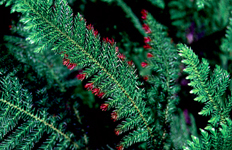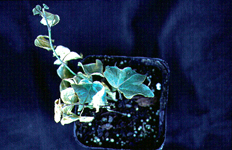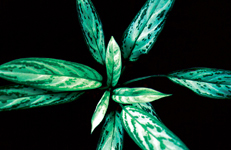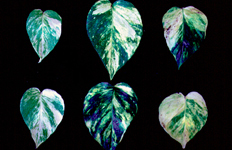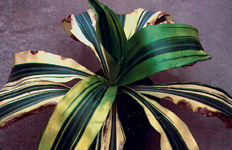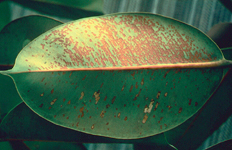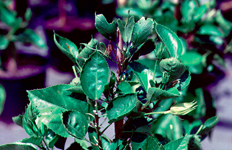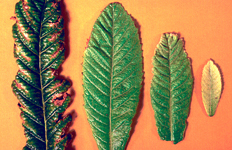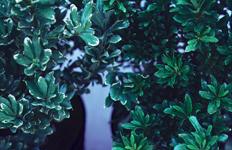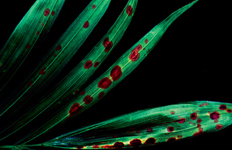|
SP 223 Plant Pathology Department, Entomology and Nematology Department
Abiotic Problems in the Ornamental Plant Nursery Sheet 1 G.W. Simone Edited for the web by L.S. Osborne
Soluble salts burn. This is damage caused by high soluble sales on Norfolk Island pine, Araucaria sp. A short period of excessive fertility produced tip burn on a short section of the scalelike leaves on emerging branches. Adjusted fertility resulted in normal leaf development on the emerging limbs.
Soluble salts burn. Excessive fertilizer produced leaf desiccation and death on the new growth of this ivy, Hedera sp. Comparable damage to the feeder toot system is also occurring form high salt stress.
Low fertility. Damage to this Aglaonema sp. is expressed as a reduced leaf size, decrease in intensity of pigmented areas, and a shift in the normal variegation pattern. Injury is due to a suboptimal fertility level in the growing medium.
Extremes of nitrogen fertility. Leaves of pothos, Epipremnum aureum, grown at three levels of nitrogen. Pictured from left: low nitrogen, optimal nitrogen and excessive nitrogen. Either extreme of nitrogen causes reduced leaf size. Low nitrogen causes more white areas of variegation and lighter greens, while high nitrogen causes a shift to more green and yellow on the leaf surface.
Foliar fertilizer phytotoxicity. These emerging Dracaena leaves are affected by high rates of fertilizer applied in liquid form over the canopy. Note the reversion of lighter green areas of variegation to darker zones.
Potassium deficiency. Rubber plant, Ficus elastica “Decora,” with potassium deficiency. Lack of this major element for plant growth produces interveinal chlorosis followed by necrosis in older leaves. Affected plants exhibit shortened petioles and stems and may develop terminal and lateral bud death.
Molybdenum deficiency. Hibiscus, southern Indian azalea, ligustrum, dogwood and loquat are all sensitive to molybdenum deficiency. Shortage of this minor element produces a growth-regulator-like herbicide injury. New growth is strap-like in appearance with leaves that are rough and thickened, with prominent veins.
Zinc deficiency. Loquat, Eriobotrya sp., with a little leaf syndrome characteristic of zinc deficiency. This minor element produces shortened internodes, new leaf chlorosis, distorted leaf margins, reduced flowering and meristem necrosis. Sensitive plants include Surinam cherry, silk oak, Japanese holly, ligustrum, Barbados cherry and elm.
Copper deficiency. Shortage of this minor element causes a reduction in leaf size, with cupped or thickened leaves. New growth flushes are shorter, with multiple bud development. Note the healthy pittosporum on the left and the deficient one on the right. Ornamentals grown in a muck-based medium (pH ≤4.7) or sandy, alkaline medium (pH ≥6.8) are often prone to copper deficiency.
Copper deficiency. Plant-damaging levels of copper can be induced through repeated applications of foliar fertilizer or minor element sprays containing copper. Excessive copper produces necrotic leaf spots, and it mimics symptoms caused by foliar fungi on palms. |
